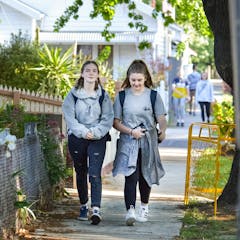
Articles sur Liveable cities
Affichage de 41 à 60 de 80 articles

Regional areas are expanding, and yet not enough attention is being paid to improving rail access to capital cities. This affects the liveability of the areas.

We spend on average about an hour a day travelling. Given this is unlikely to change, how can we make this time more productive and enjoyable?

The positive mood of tweets varies with time of day and season, but it’s consistently higher in parks than in built-up areas, where people are more likely to express anger and fears.

All around us, the places we inhabit send us physical and visual cues that influence our behaviour. Good design can tilt the balance so our surroundings help us act in ways that fulfil our needs.

The connections between city planning and health are many and varied, but getting health objectives integrated into all aspects of planning in New South Wales has been a long struggle.

Commonly used surfaces in play areas, such as “soft fall” materials and Astroturf, can heat up to 80-100°C in the sun. This makes them a hazardous design choice, especially as the climate gets hotter.

Australian cities generally minimise negative attributes such as crime, segregation and violence, but developing positive attributes such as inclusivity appears more challenging.

In Sydney, families with children now account for one in four households living in apartments. The expectations and design of apartments have not kept up with this rapid demographic change.

The benefits of walking are widely promoted, but most Australian communities still aren’t walker-friendly. Young people, who rely heavily on walking to get around, are clear about what has to change.

Australian cities generally don’t allow pet dogs on public transport. Instead, owners need their own vehicle to travel with their dogs, and it’s a surprisingly important factor in our car dependency.

Many parklets are privately funded, but these projects often allow for more public participation than more traditional public spaces.

Adaptively re-using buildings can preserve heritage while enabling new uses that help make cities more liveable and sustainable.

The State of Australian Cities Conference begins in Adelaide today. In major cities across the nation, there’s a stark contrast between lofty planning goals and the sprawling reality on the ground.

Toronto has entered a joint venture with a Google sister company to create a high-tech urban development area. The goal is to ‘re-imagine cities from the internet up’ – Google’s internet, of course.

The secret of creating attractive, liveable places sounds deceptively simple: connect people to places, people to transport and people to people.

Residents often have concerns about informal green space but some still use it. Work to enhance these areas should aim to resolve these concerns without destroying what residents do value.

One of the most effective ways to reduce health inequalities across Australia is to design neighbourhoods that free residents from having to rely on cars for transport.

Traditionally, new communities first get hard infrastructure – schools, hospitals, transport – and ‘soft’ social infrastructure comes later. Liveability and public health suffer as a result.

Governments, developers and urban planners all aspire to create liveable cities. Yet when it comes to Australian cities, the rhetoric and reality don’t quite match.

The challenge of creating liveable communities across Australia’s capital cities comes down to seven key factors. And assessed on this basis, parts of our cities don’t fare so well.
